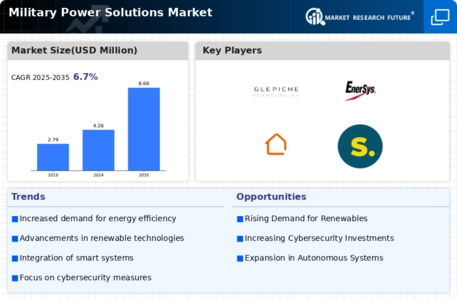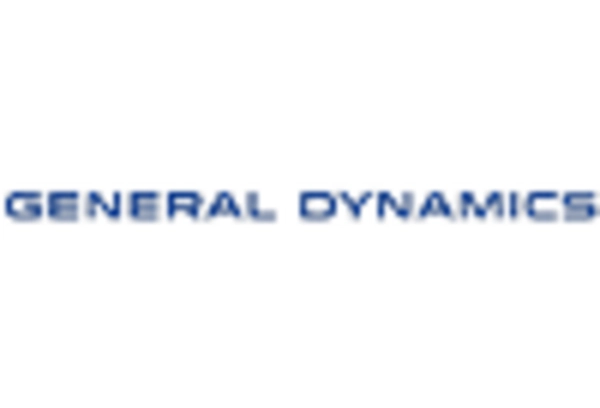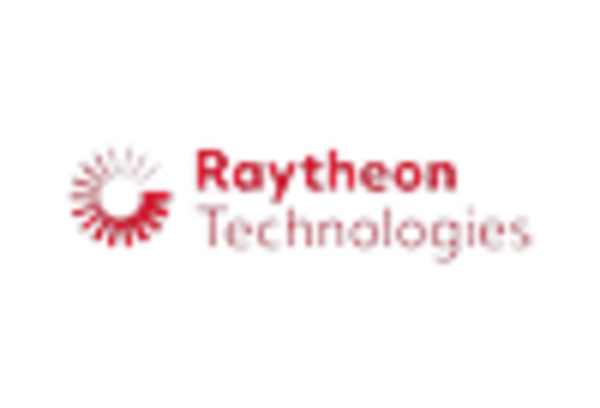-
EXECUTIVE SUMMARY 18
-
MARKET ATTRACTIVENESS ANALYSIS 20
-
MARKET INTRODUCTION 21
-
DEFINITION 21
-
SCOPE OF THE STUDY 21
-
RESEARCH OBJECTIVE 21
-
MARKET STRUCTURE 21
-
RESEARCH METHODOLOGY 22
-
MARKET INSIGHTS 28
-
MARKET DYNAMICS 30
-
MARKET DRIVERS 30
- INCREASING DEMAND FOR PORTABLE POWER SUPPLY SOLUTIONS 31
- GROWING EMERGENCE OF MODERN WARFARE TECHNIQUES 31
- RISING DEFENSE ELECTRONICS BUDGET 32
-
RESTRAINS 32
- ISSUES RELATED TO INEFFICIENCY TO GENERATE HIGH OUTPUT POWER 32
- HIGH INITIAL COST OF DEVELOPMENT 33
- HIGH COST OF THERMOELECTRIC MATERIALS 33
- STRINGENT MILITARY REGULATIONS 33
-
OPPORTUNITY 33
- INCREASING POPULARITY AND NEED FOR RENEWABLE SOURCES OF ENERGY 33
- INCREASING DEMAND FOR UAVS WHICH REQUIRE LONG-LASTING POWER SUPPLY 33
-
REGULATIONS 34
-
PATENT ANALYSIS 34
-
MARKET FACTOR ANALYSIS 36
-
VALUE CHAIN 36
- R&D AND DESIGNING 37
- MANUFACTURING 37
- DISTRIBUTION & SALES 37
- POST-SALES MONITORING 37
-
PORTER’S FIVE FORCES MODEL 38
- THREAT OF NEW ENTRANTS 39
- BARGAINING POWER OF SUPPLIERS 39
- BARGAINING POWER OF BUYERS 39
- THREAT OF SUBSTITUTES 39
- INTENSITY OF RIVALRY 39
-
IMPACT OF COVID-19 ON MILITARY POWER SOLUTIONS MARKET 39
-
GLOBAL MILITARY POWER SOLUTIONS MARKET, BY TYPE 41
-
OVERVIEW 41
- GLOBAL MILITARY POWER SOLUTIONS MARKET, BY TYPE, 2022–2030 (USD MILLION) 42
-
PORTABLE 42
-
NON-PORTABLE 42
-
GLOBAL MILITARY POWER SOLUTIONS MARKET, BY SOURCE 43
-
OVERVIEW 43
- GLOBAL MILITARY POWER SOLUTIONS MARKET, BY SOURCE, 2022–2030 (USD MILLION) 44
-
BATTERIES 44
-
GENERATORS 45
-
FUEL CELLS 45
-
SOLAR POWER 45
-
ENERGY HARVESTERS 45
-
GLOBAL MILITARY POWER SOLUTIONS MARKET, BY PLATFORM 46
-
OVERVIEW 46
- GLOBAL MILITARY POWER SOLUTIONS MARKET, BY PLATFORM, 2022–2030 (USD MILLION) 47
-
AIR 47
-
MARINE 47
-
GROUND 48
-
GLOBAL MILITARY POWER SOLUTIONS MARKET, BY WATTAGE 49
-
OVERVIEW 49
- GLOBAL MILITARY POWER SOLUTIONS MARKET, BY WATTAGE, 2022–2030 (USD MILLION) 50
-
LOW POWER 50
-
MEDIUM POWER 50
-
HIGH POWER 50
-
GLOBAL MILITARY POWER SOLUTIONS MARKET, BY REGION 52
-
OVERVIEW 52
- GLOBAL MILITARY POWER SOLUTIONS MARKET, BY REGION, 2021 VS 2030 (USD MILLION) 52
- GLOBAL MILITARY POWER SOLUTIONS MARKET, BY REGION, 2022–2030 (USD MILLION) 53
-
NORTH AMERICA 54
- NORTH AMERICA: MILITARY POWER SOLUTIONS MARKET, BY COUNTRY, 2022–2030 (USD MILLION) 55
- NORTH AMERICA MILITARY POWER SOLUTIONS MARKET, BY TYPE, 2022–2030 (USD MILLION) 56
- NORTH AMERICA MILITARY POWER SOLUTIONS MARKET, BY SOURCE, 2022–2030 (USD MILLION) 57
- NORTH AMERICA MILITARY POWER SOLUTIONS MARKET, BY PLATFORM, 2022–2030 (USD MILLION) 57
- NORTH AMERICA MILITARY POWER SOLUTIONS MARKET, BY WATTAGE, 2022–2030 (USD MILLION) 58
- US 59
- CANADA 60
-
EUROPE 61
- EUROPE: MILITARY POWER SOLUTIONS MARKET, BY COUNTRY, 2022–2030 (USD MILLION) 62
- EUROPE MILITARY POWER SOLUTIONS MARKET, BY TYPE, 2022–2030 (USD MILLION) 63
- EUROPE MILITARY POWER SOLUTIONS MARKET, BY SOURCE, 2022–2030 (USD MILLION) 63
- EUROPE MILITARY POWER SOLUTIONS MARKET, BY PLATFORM, 2022–2030 (USD MILLION) 64
- EUROPE MILITARY POWER SOLUTIONS MARKET, BY WATTAGE, 2022–2030 (USD MILLION) 65
- NETHERLANDS 65
- FRANCE 66
- GERMANY 67
- UK 68
- SPAIN 69
- ITALY 70
- SWEDEN 71
- CANADA 72
- FINLAND 73
- BELGIUM 74
- REST OF EUROPE 75
-
ASIA-PACIFIC 77
- ASIA-PACIFIC: MILITARY POWER SOLUTIONS MARKET, BY COUNTRY, 2022–2030 (USD MILLION) 78
- ASIA-PACIFIC MILITARY POWER SOLUTIONS MARKET, BY TYPE, 2022–2030 (USD MILLION) 79
- ASIA-PACIFIC MILITARY POWER SOLUTIONS MARKET, BY SOURCE, 2022–2030 (USD MILLION) 80
- ASIA-PACIFIC MILITARY POWER SOLUTIONS MARKET, BY PLATFORM, 2022–2030 (USD MILLION) 80
- ASIA-PACIFIC MILITARY POWER SOLUTIONS MARKET, BY WATTAGE, 2022–2030 (USD MILLION) 81
- CHINA 82
- JAPAN 83
- INDIA 84
- REST OD ASIA-PACICIC 85
-
REST OF THE WORLD 86
- REST OF THE WORLD: MILITARY POWER SOLUTIONS MARKET, BY COUNTRY, 2022–2030 (USD MILLION) 86
- REST OF THE WORLD MILITARY POWER SOLUTIONS MARKET, BY TYPE, 2022–2030 (USD MILLION) 87
- REST OF THE WORLD MILITARY POWER SOLUTIONS MARKET, BY SOURCE, 2022–2030 (USD MILLION) 88
- REST OF THE WORLD MILITARY POWER SOLUTIONS MARKET, BY PLATFORM, 2022–2030 (USD MILLION) 88
- REST OF THE WORLD MILITARY POWER SOLUTIONS MARKET, BY WATTAGE, 2022–2030 (USD MILLION) 89
- MIDDLE EAST & AFRICA 89
- LATIN AMERICA 91
-
COMPETITVE LANDSCAPE 92
-
COMPETITIVE BENCHMARKING 93
-
VENDOR SHARE ANALYSIS 94
-
RECENT DEVELOPMENTS 94
- PARTNERSHIPS/AGREEMENTS/CONTRACTS/COLLABORATIONS 95
-
COMPANY PROFILES 96
-
CUMMINS INC. 96
- COMPANY OVERVIEW 96
- FINANCIAL OVERVIEW 97
- PRODUCTS/SOLUTIONS/SERVICES OFFERED 98
- KEY DEVELOPMENTS 98
- SWOT ANALYSIS 99
- KEY STRATEGIES 99
-
GRESHAM POWER ELECTRONICS LIMITED 100
- COMPANY OVERVIEW 100
- FINANCIAL OVERVIEW 100
- PRODUCTS/SOLUTIONS/SERVICES OFFERED 100
- KEY DEVELOPMENTS 100
- SWOT ANALYSIS 101
- KEY STRATEGIES 101
-
EAGLEPICHER TECHNOLOGIES 102
- COMPANY OVERVIEW 102
- FINANCIAL OVERVIEW 102
- PRODUCTS/SOLUTIONS/SERVICES OFFERED 102
- KEY DEVELOPMENTS 103
- SWOT ANALYSIS 103
- KEY STRATEGIES 103
-
ENERSYS. 104
- COMPANY OVERVIEW 104
- FINANCIAL OVERVIEW 104
- PRODUCTS/SOLUTIONS/SERVICES OFFERED 105
- KEY DEVELOPMENTS 105
- SWOT ANALYSIS 106
- KEY STRATEGIES 106
-
SAFT 107
- COMPANY OVERVIEW 107
- FINANCIAL OVERVIEW 107
- PRODUCTS/SOLUTIONS/SERVICES OFFERED 108
- KEY DEVELOPMENTS 108
- SWOT ANALYSIS 109
- KEY STRATEGIES 109
-
SCHAEFER,INC. 110
- COMPANY OVERVIEW 110
- FINANCIAL OVERVIEW 110
- PRODUCTS/SOLUTIONS/SERVICES OFFERED 110
- KEY DEVELOPMENTS 111
- SWOT ANALYSIS 111
- KEY STRATEGIES 111
-
AROTECH CORPORATION. 112
- COMPANY OVERVIEW 112
- FINANCIAL OVERVIEW 112
- PRODUCTS/SOLUTIONS/SERVICES OFFERED 113
- KEY DEVELOPMENTS 113
-
SFC ENERGY AG 114
- COMPANY OVERVIEW 114
- FINANCIAL OVERVIEW 114
- PRODUCTS/SOLUTIONS/SERVICES OFFERED 115
- KEY DEVELOPMENTS 115
- SWOT ANALYSIS 116
- KEY STRATEGIES 116
-
RAYTHEON TECHNOLOGIES CORPORATION 117
- COMPANY OVERVIEW 117
- FINANCIAL OVERVIEW 118
- PRODUCTS/SOLUTIONS/SERVICES OFFERED 119
- KEY DEVELOPMENTS 119
- SWOT ANALYSIS 120
- KEY STRATEGIES 120
-
GS YUASA CORPORATION 121
- COMPANY OVERVIEW 121
- FINANCIAL OVERVIEW 122
- PRODUCTS/SOLUTIONS/SERVICES OFFERED 123
- KEY DEVELOPMENTS 123
- SWOT ANALYSIS 124
- KEY STRATEGIES 124
-
-
LIST OF TABLES
-
MAJOR GRANTED PATENTS ON MILITARY POWER SOLUTIONS 34
-
GLOBAL MILITARY POWER SOLUTIONS MARKET, BY TYPE, 2022–2030 (USD MILLION) 42
-
GLOBAL MILITARY POWER SOLUTIONS MARKET, BY SOURCE, 2022–2030 (USD MILLION) 44
-
GLOBAL MILITARY POWER SOLUTIONS MARKET, BY PLATFORM, 2022–2030 (USD MILLION) 47
-
GLOBAL MILITARY POWER SOLUTIONS MARKET, BY WATTAGE, 2022–2030 (USD MILLION) 50
-
GLOBAL MILITARY POWER SOLUTIONS MARKET, BY REGION, 2022–2030 (USD MILLION) 53
-
NORTH AMERICA MILITARY POWER SOLUTIONS MARKET, BY COUNTRY, 2022–2030 (USD MILLION) 55
-
NORTH AMERICA MILITARY POWER SOLUTIONS MARKET, BY TYPE, 2022–2030 (USD MILLION) 56
-
NORTH AMERICA MILITARY POWER SOLUTIONS MARKET, BY SOURCE, 2022–2030 (USD MILLION) 57
-
NORTH AMERICA MILITARY POWER SOLUTIONS MARKET, BY PLATFORM, 2022–2030 (USD MILLION) 57
-
NORTH AMERICA MILITARY POWER SOLUTIONS MARKET, BY WATTAGE, 2022–2030 (USD MILLION) 58
-
US MILITARY POWER SOLUTIONS MARKET, BY TYPE, 2022–2030 (USD MILLION) 59
-
US MILITARY POWER SOLUTIONS MARKET, BY SOURCE, 2022–2030 (USD MILLION) 59
-
US MILITARY POWER SOLUTIONS MARKET, BY PLATFORM, 2022–2030 (USD MILLION) 59
-
US MILITARY POWER SOLUTIONS MARKET, BY WATTAGE, 2022–2030 (USD MILLION) 59
-
CANADA MILITARY POWER SOLUTIONS MARKET, BY TYPE, 2022–2030 (USD MILLION) 60
-
CANADA MILITARY POWER SOLUTIONS MARKET, BY SOURCE, 2022–2030 (USD MILLION) 60
-
CANADA MILITARY POWER SOLUTIONS MARKET, BY PLATFORM, 2022–2030 (USD MILLION) 60
-
CANADA MILITARY POWER SOLUTIONS MARKET, BY WATTAGE, 2022–2030 (USD MILLION) 60
-
EUROPE MILITARY POWER SOLUTIONS MARKET, BY COUNTRY, 2022–2030 (USD MILLION) 62
-
EUROPE MILITARY POWER SOLUTIONS MARKET, BY TYPE, 2022–2030 (USD MILLION) 63
-
EUROPE MILITARY POWER SOLUTIONS MARKET, BY SOURCE, 2022–2030 (USD MILLION) 63
-
EUROPE MILITARY POWER SOLUTIONS MARKET, BY PLATFORM, 2022–2030 (USD MILLION) 64
-
EUROPE MILITARY POWER SOLUTIONS MARKET, BY WATTAGE, 2022–2030 (USD MILLION) 65
-
NETHERLANDS MILITARY POWER SOLUTIONS MARKET, BY TYPE, 2022–2030 (USD MILLION) 65
-
NETHERLANDS MILITARY POWER SOLUTIONS MARKET, BY SOURCE, 2022–2030 (USD MILLION) 65
-
NETHERLANDS MILITARY POWER SOLUTIONS MARKET, BY PLATFORM, 2022–2030 (USD MILLION) 65
-
NETHERLANDS MILITARY POWER SOLUTIONS MARKET, BY WATTAGE, 2022–2030 (USD MILLION) 66
-
FRANCE MILITARY POWER SOLUTIONS MARKET, BY TYPE, 2022–2030 (USD MILLION) 66
-
FRANCE MILITARY POWER SOLUTIONS MARKET, BY SOURCE, 2022–2030 (USD MILLION) 66
-
FRANCE MILITARY POWER SOLUTIONS MARKET, BY PLATFORM, 2022–2030 (USD MILLION) 66
-
FRANCE MILITARY POWER SOLUTIONS MARKET, BY WATTAGE, 2022–2030 (USD MILLION) 67
-
GERMANY MILITARY POWER SOLUTIONS MARKET, BY TYPE, 2022–2030 (USD MILLION) 67
-
GERMANY MILITARY POWER SOLUTIONS MARKET, BY SOURCE, 2022–2030 (USD MILLION) 67
-
GERMANY MILITARY POWER SOLUTIONS MARKET, BY PLATFORM, 2022–2030 (USD MILLION) 67
-
GERMANY MILITARY POWER SOLUTIONS MARKET, BY WATTAGE, 2022–2030 (USD MILLION) 68
-
UK MILITARY POWER SOLUTIONS MARKET, BY TYPE, 2022–2030 (USD MILLION) 68
-
UK MILITARY POWER SOLUTIONS MARKET, BY SOURCE, 2022–2030 (USD MILLION) 68
-
UK MILITARY POWER SOLUTIONS MARKET, BY PLATFORM, 2022–2030 (USD MILLION) 68
-
UK MILITARY POWER SOLUTIONS MARKET, BY WATTAGE, 2022–2030 (USD MILLION) 69
-
SPAIN MILITARY POWER SOLUTIONS MARKET, BY TYPE, 2022–2030 (USD MILLION) 69
-
SPAIN MILITARY POWER SOLUTIONS MARKET, BY SOURCE, 2022–2030 (USD MILLION) 69
-
SPAIN MILITARY POWER SOLUTIONS MARKET, BY PLATFORM, 2022–2030 (USD MILLION) 69
-
SPAIN MILITARY POWER SOLUTIONS MARKET, BY WATTAGE, 2022–2030 (USD MILLION) 70
-
ITALY MILITARY POWER SOLUTIONS MARKET, BY TYPE, 2022–2030 (USD MILLION) 70
-
ITALY MILITARY POWER SOLUTIONS MARKET, BY SOURCE, 2022–2030 (USD MILLION) 70
-
ITALY MILITARY POWER SOLUTIONS MARKET, BY PLATFORM, 2022–2030 (USD MILLION) 70
-
ITALY MILITARY POWER SOLUTIONS MARKET, BY WATTAGE, 2022–2030 (USD MILLION) 71
-
SWEDEN MILITARY POWER SOLUTIONS MARKET, BY TYPE, 2022–2030 (USD MILLION) 71
-
SWEDEN MILITARY POWER SOLUTIONS MARKET, BY SOURCE, 2022–2030 (USD MILLION) 71
-
SWEDEN MILITARY POWER SOLUTIONS MARKET, BY PLATFORM, 2022–2030 (USD MILLION) 71
-
SWEDEN MILITARY POWER SOLUTIONS MARKET, BY WATTAGE, 2022–2030 (USD MILLION) 72
-
DENMARK MILITARY POWER SOLUTIONS MARKET, BY TYPE, 2022–2030 (USD MILLION) 72
-
DENMARK MILITARY POWER SOLUTIONS MARKET, BY SOURCE, 2022–2030 (USD MILLION) 72
-
DENMARK MILITARY POWER SOLUTIONS MARKET, BY PLATFORM, 2022–2030 (USD MILLION) 72
-
DENMARK MILITARY POWER SOLUTIONS MARKET, BY WATTAGE, 2022–2030 (USD MILLION) 73
-
FINLAND MILITARY POWER SOLUTIONS MARKET, BY TYPE, 2022–2030 (USD MILLION) 73
-
FINLAND MILITARY POWER SOLUTIONS MARKET, BY SOURCE, 2022–2030 (USD MILLION) 73
-
FINLAND MILITARY POWER SOLUTIONS MARKET, BY PLATFORM, 2022–2030 (USD MILLION) 73
-
FINLAND MILITARY POWER SOLUTIONS MARKET, BY WATTAGE, 2022–2030 (USD MILLION) 74
-
BELGIUM MILITARY POWER SOLUTIONS MARKET, BY TYPE, 2022–2030 (USD MILLION) 74
-
BELGIUM MILITARY POWER SOLUTIONS MARKET, BY SOURCE, 2022–2030 (USD MILLION) 74
-
BELGIUM MILITARY POWER SOLUTIONS MARKET, BY PLATFORM, 2022–2030 (USD MILLION) 74
-
BELGIUM MILITARY POWER SOLUTIONS MARKET, BY WATTAGE, 2022–2030 (USD MILLION) 75
-
REST OF EUROPE MILITARY POWER SOLUTIONS MARKET, BY TYPE, 2022–2030 (USD MILLION) 75
-
REST OF EUROPE MILITARY POWER SOLUTIONS MARKET, BY SOURCE, 2022–2030 (USD MILLION) 75
-
REST OF EUROPE MILITARY POWER SOLUTIONS MARKET, BY PLATFORM, 2022–2030 (USD MILLION) 75
-
REST OF EUROPE MILITARY POWER SOLUTIONS MARKET, BY WATTAGE, 2022–2030 (USD MILLION) 76
-
ASIA-PACIFIC MILITARY POWER SOLUTIONS MARKET, BY COUNTRY, 2022–2030 (USD MILLION) 78
-
ASIA-PACIFIC MILITARY POWER SOLUTIONS MARKET, BY TYPE, 2022–2030 (USD MILLION) 79
-
ASIA-PACIFIC MILITARY POWER SOLUTIONS MARKET, BY SOURCE, 2022–2030 (USD MILLION) 80
-
ASIA-PACIFIC MILITARY POWER SOLUTIONS MARKET, BY PLATFORM, 2022–2030 (USD MILLION) 80
-
ASIA-PACIFIC MILITARY POWER SOLUTIONS MARKET, BY WATTAGE, 2022–2030 (USD MILLION) 81
-
CHINA MILITARY POWER SOLUTIONS MARKET, BY TYPE, 2022–2030 (USD MILLION) 82
-
CHINA MILITARY POWER SOLUTIONS MARKET, BY SOURCE, 2022–2030 (USD MILLION) 82
-
CHINA MILITARY POWER SOLUTIONS MARKET, BY PLATFORM, 2022–2030 (USD MILLION) 82
-
CHINA MILITARY POWER SOLUTIONS MARKET, BY WATTAGE, 2022–2030 (USD MILLION) 82
-
JAPAN MILITARY POWER SOLUTIONS MARKET, BY TYPE, 2022–2030 (USD MILLION) 83
-
JAPAN MILITARY POWER SOLUTIONS MARKET, BY SOURCE, 2022–2030 (USD MILLION) 83
-
JAPAN MILITARY POWER SOLUTIONS MARKET, BY PLATFORM, 2022–2030 (USD MILLION) 83
-
JAPAN MILITARY POWER SOLUTIONS MARKET, BY WATTAGE, 2022–2030 (USD MILLION) 83
-
INDIA MILITARY POWER SOLUTIONS MARKET, BY TYPE, 2022–2030 (USD MILLION) 84
-
INDIA MILITARY POWER SOLUTIONS MARKET, BY SOURCE, 2022–2030 (USD MILLION) 84
-
INDIA MILITARY POWER SOLUTIONS MARKET, BY PLATFORM, 2022–2030 (USD MILLION) 84
-
INDIA MILITARY POWER SOLUTIONS MARKET, BY WATTAGE, 2022–2030 (USD MILLION) 84
-
REST OF ASIA-PACIFIC MILITARY POWER SOLUTIONS MARKET, BY TYPE, 2022–2030 (USD MILLION) 85
-
REST OF ASIA-PACIFIC MILITARY POWER SOLUTIONS MARKET, BY SOURCE, 2022–2030 (USD MILLION) 85
-
REST OF ASIA-PACIFIC MILITARY POWER SOLUTIONS MARKET, BY PLATFORM, 2022–2030 (USD MILLION) 85
-
REST OF ASIA-PACIFIC MILITARY POWER SOLUTIONS MARKET, BY WATTAGE, 2022–2030 (USD MILLION) 85
-
REST OF THE WORLD MILITARY POWER SOLUTIONS MARKET, BY COUNTRY, 2022–2030 (USD MILLION) 86
-
REST OF THE WORLD MILITARY POWER SOLUTIONS MARKET, BY TYPE, 2022–2030 (USD MILLION) 87
-
REST OF THE WORLD MILITARY POWER SOLUTIONS MARKET, BY SOURCE, 2022–2030 (USD MILLION) 88
-
REST OF THE WORLD MILITARY POWER SOLUTIONS MARKET, BY PLATFORM, 2022–2030 (USD MILLION) 88
-
REST OF THE WORLD MILITARY POWER SOLUTIONS MARKET, BY WATTAGE, 2022–2030 (USD MILLION) 89
-
MIDDLE EAST & AFRICA MILITARY POWER SOLUTIONS MARKET, BY TYPE, 2022–2030 (USD MILLION) 89
-
MIDDLE EAST & AFRICA MILITARY POWER SOLUTIONS MARKET, BY SOURCE, 2022–2030 (USD MILLION) 90
-
MIDDLE EAST & AFRICA MILITARY POWER SOLUTIONS MARKET, BY PLATFORM, 2022–2030 (USD MILLION) 90
-
MIDDLE EAST & AFRICA MILITARY POWER SOLUTIONS MARKET, BY WATTAGE, 2022–2030 (USD MILLION) 90
-
LATIN AMERICA MILITARY POWER SOLUTIONS MARKET, BY TYPE, 2022–2030 (USD MILLION) 91
-
LATIN AMERICA MILITARY POWER SOLUTIONS MARKET, BY SOURCE, 2022–2030 (USD MILLION) 91
-
LATIN AMERICA MILITARY POWER SOLUTIONS MARKET, BY PLATFORM, 2022–2030 (USD MILLION) 91
-
LATIN AMERICA MILITARY POWER SOLUTIONS MARKET, BY WATTAGE, 2022–2030 (USD MILLION) 91
-
PRODUCT DEVELOPMENT/ANNOUNCEMENT 94
-
PARTNERSHIPS/AGREEMENTS/CONTRACTS/COLLABORATIONS 95
-
CUMMINS INC.: PRODUCTS/SOLUTIONS/SERVICES OFFERED 98
-
CUMMINS INC.: KEY DEVELOPMENTS 98
-
GRESHAM POWER ELECTRONICS LIMITED: PRODUCTS/SOLUTIONS/SERVICES OFFERED 100
-
GRESHAM POWER ELECTRONICS LIMITED: KEY DEVELOPMENTS 100
-
EAGLEPICHER TECHNOLOGIES: PRODUCTS/SOLUTIONS/SERVICES OFFERED 102
-
EAGLEPICHER TECHNOLOGIES : KEY DEVELOPMENTS 103
-
ENERSYS. : PRODUCTS/SOLUTIONS/SERVICES OFFERED 105
-
ENERSYS. : KEY DEVELOPMENTS 105
-
SAFT: PRODUCTS/SOLUTIONS/SERVICES OFFERED 108
-
SAFT: KEY DEVELOPMENTS 108
-
SCHAEFER,INC: PRODUCTS/SOLUTIONS/SERVICES OFFERED 110
-
SCHAEFER,INC: KEY DEVELOPMENTS 111
-
AROTECH CORPORATION: PRODUCTS/SOLUTIONS/SERVICES OFFERED 113
-
SFC ENERGY AG: PRODUCTS/SOLUTIONS/SERVICES OFFERED 115
-
SFC ENERGY AG: KEY DEVELOPMENTS 115
-
RAYTHEON TECHNOLOGIES CORPORATION: PRODUCTS/SOLUTIONS/SERVICES OFFERED 119
-
RAYTHEON TECHNOLOGIES CORPORATION: KEY DEVELOPMENTS 119
-
GS YUASA CORPORATION: PRODUCTS/SOLUTIONS/SERVICES OFFERED 123
-
GS YUASA CORPORATION: KEY DEVELOPMENTS 123
-
-
LIST OF FIGURES
-
MARKET SYNOPSIS 19
-
MARKET ATTRACTIVENESS ANALYSIS: GLOBAL MILITARY POWER SOLUTIONS MARKET 20
-
GLOBAL MILITARY POWER SOLUTIONS MARKET: STRUCTURE 21
-
BOTTOM-UP AND TOP-DOWN APPROACHES 26
-
NORTH AMERICA: MILITARY POWER SOLUTIONS MARKET SIZE & MARKET SHARE, BY COUNTRY(2021 VS 2030) 28
-
EUROPE: MILITARY POWER SOLUTIONS MARKET SIZE & MARKET SHARE, BY COUNTRY(2021 VS 2030) 28
-
ASIA-PACIFIC: MILITARY POWER SOLUTIONS MARKET SIZE & MARKET SHARE, BY COUNTRY(2021 VS 2030) 28
-
REST OF THE WORLD MILITARY POWER SOLUTIONS MARKET SIZE & MARKET SHARE, BY COUNTRY(2021 VS 2030) 29
-
GLOBAL MILITARY POWER SOLUTIONS MARKET: DRIVERS & RESTRAINT 30
-
DRIVER IMPACT ANALYSIS 31
-
RESTRAINT IMPACT ANALYSIS 32
-
VALUE CHAIN ANALYSIS OF THE GLOBAL MILITARY POWER SOLUTIONS MARKET 36
-
PORTER'S FIVE FORCES ANALYSIS OF THE GLOBAL MILITARY POWER SOLUTIONS MARKET 38
-
GLOBAL MILITARY POWER SOLUTIONS MARKET, BY TYPE, 2021 (% SHARE) 41
-
GLOBAL MILITARY POWER SOLUTIONS MARKET, BY TYPE, 2021 VS 2030 (USD MILLION) 41
-
GLOBAL MILITARY POWER SOLUTIONS MARKET, BY SOURCE, 2021 (% SHARE) 43
-
GLOBAL MILITARY POWER SOLUTIONS MARKET, BY SOURCE, 2021 VS 2030 (USD MILLION) 44
-
GLOBAL MILITARY POWER SOLUTIONS MARKET, BY PLATFORM, 2021 (% SHARE) 46
-
GLOBAL MILITARY POWER SOLUTIONS MARKET, BY PLATFORM, 2021 VS 2030 (USD MILLION) 46
-
GLOBAL MILITARY POWER SOLUTIONS MARKET, BY WATTAGE, 2021 (% SHARE) 49
-
GLOBAL MILITARY POWER SOLUTIONS MARKET, BY WATTAGE, 2021 VS 2030 (USD MILLION) 49
-
GLOBAL MILITARY POWER SOLUTIONS MARKET, BY REGION, 2021 (% SHARE) 52
-
GLOBAL MILITARY POWER SOLUTIONS MARKET, BY REGION, 2021 VS 2030 (USD MILLION) 52
-
NORTH AMERICA MILITARY POWER SOLUTIONS MARKET, BY COUNTRY, 2021 (% SHARE) 55
-
NORTH AMERICA MILITARY POWER SOLUTIONS MARKET, BY COUNTRY, 2021 VS 2030 (USD MILLION) 55
-
NORTH AMERICA MILITARY POWER SOLUTIONS MARKET, BY TYPE, 2022-2030 (USD MILLION) 56
-
NORTH AMERICA MILITARY POWER SOLUTIONS MARKET, BY SOURCE, 2022-2030 (USD MILLION) 56
-
NORTH AMERICA MILITARY POWER SOLUTIONS MARKET, BY PLATFORM, 2022-2030 (USD MILLION) 57
-
NORTH AMERICA MILITARY POWER SOLUTIONS MARKET, BY WATTAGE, 2022-2030 (USD MILLION) 58
-
EUROPE MILITARY POWER SOLUTIONS MARKET, BY COUNTRY, 2021 (% SHARE) 61
-
EUROPE MILITARY POWER SOLUTIONS MARKET, BY COUNTRY, 2021 VS 2030 (USD MILLION) 62
-
EUROPE MILITARY POWER SOLUTIONS MARKET, BY TYPE, 2022-2030 (USD MILLION) 62
-
EUROPE MILITARY POWER SOLUTIONS MARKET, BY SOURCE, 2022-2030 (USD MILLION) 63
-
EUROPE MILITARY POWER SOLUTIONS MARKET, BY PLATFORM, 2022-2030 (USD MILLION) 64
-
EUROPE MILITARY POWER SOLUTIONS MARKET, BY WATTAGE, 2022-2030 (USD MILLION) 64
-
ASIA-PACIFIC MILITARY POWER SOLUTIONS MARKET, BY COUNTRY, 2021 (% SHARE) 78
-
ASIA-PACIFIC MILITARY POWER SOLUTIONS MARKET, BY COUNTRY, 2021 VS 2030 (USD MILLION) 78
-
ASIA-PACIFIC MILITARY POWER SOLUTIONS MARKET, BY TYPE, 2022-2030 (USD MILLION) 79
-
ASIA-PACIFIC MILITARY POWER SOLUTIONS MARKET, BY SOURCE, 2022-2030 (USD MILLION) 79
-
ASIA-PACIFIC MILITARY POWER SOLUTIONS MARKET, BY PLATFORM, 2022-2030 (USD MILLION) 80
-
ASIA-PACIFIC MILITARY POWER SOLUTIONS MARKET, BY WATTAGE, 2022-2030 (USD MILLION) 81
-
REST OF THE WORLD MILITARY POWER SOLUTIONS MARKET, BY COUNTRY, 2021 (% SHARE) 86
-
REST OF THE WORLD MILITARY POWER SOLUTIONS MARKET, BY COUNTRY, 2021 VS 2030 (USD MILLION) 86
-
REST OF THE WORLD MILITARY POWER SOLUTIONS MARKET, BY TYPE, 2022-2030 (USD MILLION) 87
-
REST OF THE WORLD MILITARY POWER SOLUTIONS MARKET, BY SOURCE, 2022-2030 (USD MILLION) 87
-
REST OF THE WORLD MILITARY POWER SOLUTIONS MARKET, BY PLATFORM, 2022-2030 (USD MILLION) 88
-
REST OF THE WORLD MILITARY POWER SOLUTIONS MARKET, BY WATTAGE, 2022-2030 (USD MILLION) 89
-
GLOBAL MILITARY POWER SOLUTIONS MARKET: COMPETITIVE BENCHMARKING 93
-
GLOBAL MILITARY POWER SOLUTIONS MARKET: COMPETITIVE BENCHMARKING 94
-
CUMMINS INC.: FINANCIAL OVERVIEW SNAPSHOT 97
-
CUMMINS INC.: SWOT ANALYSIS 99
-
GRESHAM POWER ELECTRONICS LIMITED: SWOT ANALYSIS 101
-
EAGLEPICHER TECHNOLOGIES: SWOT ANALYSIS 103
-
ENERSYS. : FINANCIAL OVERVIEW SNAPSHOT 104
-
ENERSYS.: SWOT ANALYSIS 106
-
SAFT.: FINANCIAL OVERVIEW SNAPSHOT 107
-
SAFT.: SWOT ANALYSIS 109
-
SCHAEFER,INC: SWOT ANALYSIS 111
-
SFC ENERGY AG: FINANCIAL OVERVIEW SNAPSHOT 114
-
SFC ENERGY AG: SWOT ANALYSIS 116
-
RAYTHEON TECHNOLOGIES CORPORATION.: FINANCIAL OVERVIEW SNAPSHOT 118
-
RAYTHEON TECHNOLOGIES CORPORATION.: SWOT ANALYSIS 120
-
GS YUASA CORPORATION: FINANCIAL OVERVIEW SNAPSHOT 122
-
GS YUASA CORPORATION.: SWOT ANALYSIS 124
-
-
"

















Leave a Comment